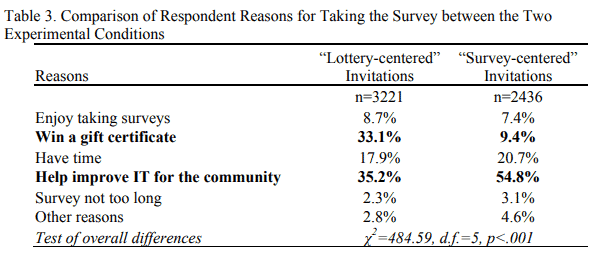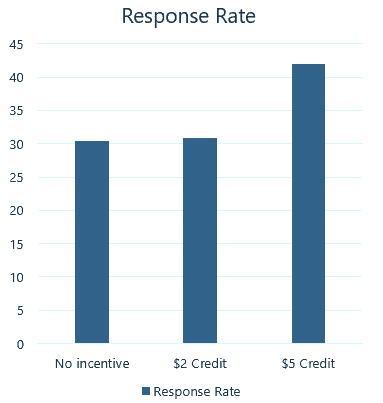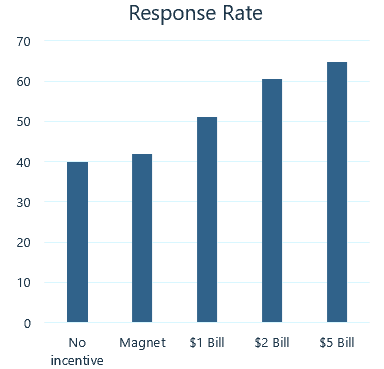Sitting with management at the final review for your customer survey questionnaire someone is going to ask about the incentive for survey completions.
It’s a good question but what is the right answer?
It depends on a lot of factors.
In this post we’ll examine the research and add it to our experience over 20 years and millions of survey responses to provide you with a plan of action.
Do You Need an Incentive?
The role of a survey incentive is to get you more customer feedback survey responses. So the first question is:
Do you need more customer feedback survey responses?
While a 100% response rate would be nice, it’s not practical. On the other hand 0% is not practical either. So what is the minimum you need?
In a typically statistical answer; it depends. As few as 5 responses can provide a very good indication of an issue if they are consistent. Where responses are not as consistent the number of responses typically needs to be higher.
Depending on these factors there is a minimum acceptable response rate.
You should use a survey response rate calculator to determine the range of response numbers that will be effective in your situations as it be surprising. Sometimes a 1% response rate is fine, sometimes you need 20%, occasionally more.

Do Survey Incentives Work?
In short yes, incentives do increase the number of responses you receive for a customer feedback survey.
Andrew Cook’s company recently performed some long-term tests and indicated that:
“[an] 8% increase in the number of responses received across channels, this varies slightly on the channel of feedback used”
In testing by Iron Mountain, they found a charitable donation incentive lifted NPS survey response rates by around 30%. However, this lift dropped over time as repeated respondents received the same offer in future survey rounds.
Other research also indicates that, generally, incentives do work to increase response rates, when implemented in the right way.
Potential Downsides of Survey Incentives
While incentives can be effective in boosting response rates, they also come with potential drawbacks that should be carefully considered.
Attracting “Reward Seekers”
Offering incentives may attract respondents who are primarily interested in the reward rather than providing thoughtful feedback. These “reward seekers” might rush through the survey, providing low-quality or random responses just to claim the incentive.
Indeed, in this research published on BioMed Central, up to 18% of respondents in incentivised surveys may only be participating for the prize, rather than contributing useful data.
This can also be seen in this research that showed a lottery incentive changed the primary reason for responding.

It would be easy to imagine that responses from people focused on winning the gift certificate might be less considered than those focused on helping. In the case of this research, they concluded it did not change the accuracy.
Risk of Biased Results
Incentives can potentially skew your survey results. Respondents might feel obligated to provide more positive feedback or answers they think you want to hear, especially if the incentive is provided by the company being evaluated. This can lead to overly optimistic or inaccurate data.
And in fact, as part of his research Andrew Cook found that incentives did indeed increase the customer feedback score by 4% across the board.
Reduced Data Quality
In their haste to complete the survey and claim the reward, some respondents might not read questions carefully or might provide superficial answers to open-ended questions. This can result in less insightful or reliable data.
However, research indicates that when used correctly, incentives do not change the reliability of data by respondents. This has been shown in several studies.
Increased Costs
Depending on the type and value of incentives offered, the costs can quickly add up, especially for large-scale surveys. This can strain budgets and potentially limit sample sizes.
Administrative Burden
Managing and distributing incentives can be time-consuming and complex, particularly for physical rewards or large-scale surveys. This additional administrative work can slow down the research process.
Ethical Concerns
In some contexts, particularly in academic or medical research, offering incentives might be seen as a form of undue influence or coercion, raising ethical questions about the voluntary nature of participation.
Expectations for Future Surveys
Once you start offering incentives, respondents might come to expect them for all future surveys, making it difficult to conduct non-incentivized research in the future.
As delivery consistency is an important aspect of customer feedback design, you should either use an incentive or not.
Changing mid-way along will impact on your ability to compare historical scores – see above for the impact on customer satisfaction scores.
Potential for Fraud
Without proper safeguards, there’s a risk of individuals attempting to take the survey multiple times to claim additional rewards, potentially skewing your results and inflating costs.
Best Types of Incentives
So if incentives work, and they don’t skew our data too much, which ones are the most effective?
There are lots of different types of incentives but they come down to just a few different main variations.
Aside: In all of these discussions, I would typically not suggest giving respondents a “credit on their account”, particularly for business customers .This is not personal or “real” enough to have a substantial impact.
Promised Incentive
A promised survey incentive is where you give something of value to everyone who completes the survey.
The exact type of incentive can vary from custom branded merchandise, to gift cards and physical products but cash typically generates the largest change in behaviour on a value for value basis.
Critically, the value must be substantial enough to drive action. In this research (“Money Will Solve the Problem”: Testing the Effectiveness of Conditional Incentives for Online Surveys) different values of incentive were tested.
A $5 reward lifted response rates by 30% but a $2 reward had, basically, no impact. So the value must be seen as worthwhile.

Pre-paid Incentive
A pre-paid survey incentive is given to everyone who receives the invite, regardless of whether they respond or not.
In on-line surveys, vouchers are often used instead of cash as they are easier to process.
While this may seem crazy, it can be a very cost effective solution because a pre-paid incentive has a much higher impact on response rate than a promised incentive. Thus you can use a smaller incentive and generate a larger response rate.
In this research a range of pre-paid incentives were tested and created substantial lifts in response rate. Even a $1 offer lifted rates by around 25%. Compare that to the zero impact a $2 incentive had in the campaign above.

It may appear strange, that a non-contingent reward can influence people but I believe basic human nature is at play. In his book Influence, Robert Cialdini outlines how important reciprocation is in the human psyche.
Small gifts can generate enormous obligations in the receiver’s mind. The small “gift” of the pre-paid incentive generates an uninvited debt that can be quickly repaid through responding to the survey.
On the other hand the promised incentive is interpreted as a “payment for the service” of responding to the survey. Now the incentive must be much larger and for many senior executive or high income people this calculation of their “hourly wage” will be far below what they perceive to be worthwhile. Thus they will not respond. It may even discourage them from responding.
As more evidence of the success of this pre-paid incentive approach, InMoment showed that prepaid incentives (such as a $1 upfront reward) can improve response rates by as much as 19%.
And in one last example from the US Department of Veterans Affairs, they discovered a promised $5.00 cash incentive delivered 30% higher response rate but paying the $5.00 up front increased response rates by 50%.
This also leads me to believe that pre-paid incentives may be very effective for those difficult to get senior executive and high income respondents. Although I have no evidence of this.
Lottery or Sweepstakes Incentives
A lottery survey incentive is where the respondent is entered into in a lottery to win a substantial prize as payment for responding. Lottery incentives are effective in lifting response rates.
In this research (Understanding the Impact of Lottery Incentives on Web Survey Participation and Response Quality: A Leverage-salience Theory Perspective) that lift was 26.6% (from 19.9% to 25.2%)
The research generally indicates that a lottery incentive has about the same impact as a straight payment for the respondent.
However, specific tests of lotteries against other types of incentives or no incentives show that lotteries are no more effective in web surveys than in other kinds of surveys: in most tests, lotteries did not significantly increase response rates over a no-incentive or alternative incentive group.
The Use and Effects of Incentives in Surveys
In addition lotteries are generally more difficult to administer as they will often require registration and government approval. The regulations vary depending on country and state making the process complex for national and international implementations.
Personal Incentive Vs Donation to Charity
Here the research is strong and indicates that promised donations to charities have a lower impact than payments or vouchers to the respondent themselves.
What I do not have is any research on the effectiveness of pre-paid donations to charity, e.g. : “We have donated $5 to [insert charity] in your name”.
Based on the above evidence these may well be very effective for senior executives. The “in your name” part would be important in this case to create the personal reciprocity element.
How to Implement Effective Survey Incentives
Step 1: Maximise the Response Rate Without Incentive
Good survey design and execution will often yield effective response rates with no need for an incentive.
Elements of a good design include:
- Making the survey as short as possible: Don’t make it a Christmas tree survey with questions added by everyone in the organisation until it blows out to 15 pages of junk that no-one will ever complete.
- Do something with the information: If you actually listen to the customer and close the loop with them, and follow up on surveys will have higher response rates.
- Use a reminder: In our experience a simple reminder a few days after the initial invite will lift response rates by 50%-100%, as much as many incentives.
Check out this complete guide of all the ways to maximise your survey response rate, without an incentive.
If you still don’t have a higher enough response rate move on to Step 2.
Step 2: Select The Best Incentive for your Situation
Based on your audience select the most appropriate incentive:
Promised
Needs to be a relatively larger incentive. Administration of providing it to each respondent can be substantial
Pre-Paid
Can be a smaller incentive and administration can be more simple, as everyone receives the incentive.
Lottery
Needs to be a larger incentive and includes potentially significant administration and legal requirements to run a lottery/sweepstakes
Survey Incentive FAQ
Lorem ipsum dolor sit amet, consectetur adipiscing elit, sed do eiusmod tempor incididunt ut labore et dolore magna aliqua. Ut enim ad minim veniam, quis nostrud exercitation ullamco laboris nisi ut aliquip ex ea commodo consequat.
Lorem ipsum dolor sit amet, consectetur adipiscing elit, sed do eiusmod tempor incididunt ut labore et dolore magna aliqua. Ut enim ad minim veniam, quis nostrud exercitation ullamco laboris nisi ut aliquip ex ea commodo consequat.

Originally published: 4 March 2014. Last Updated: 21 October 2024




